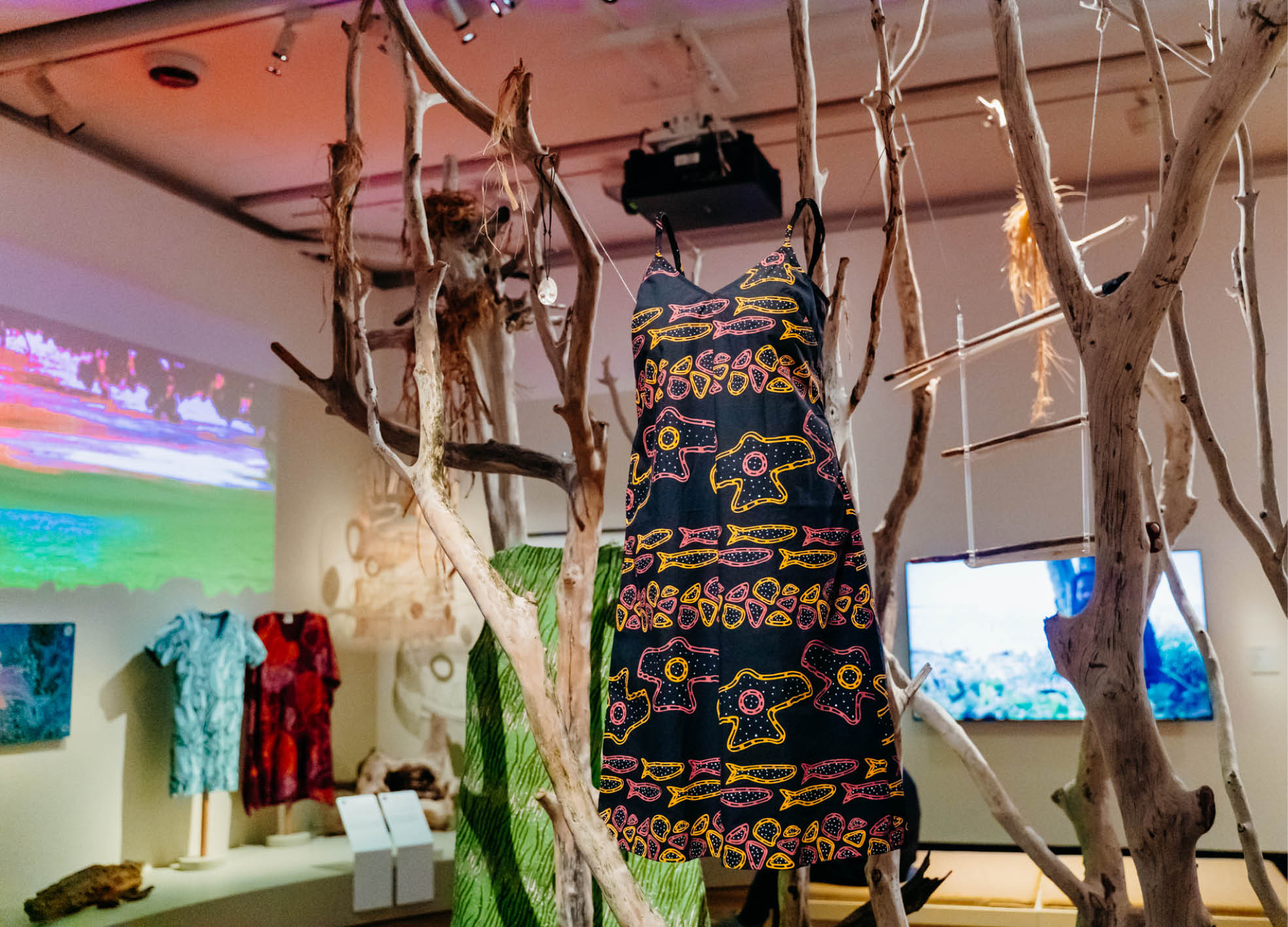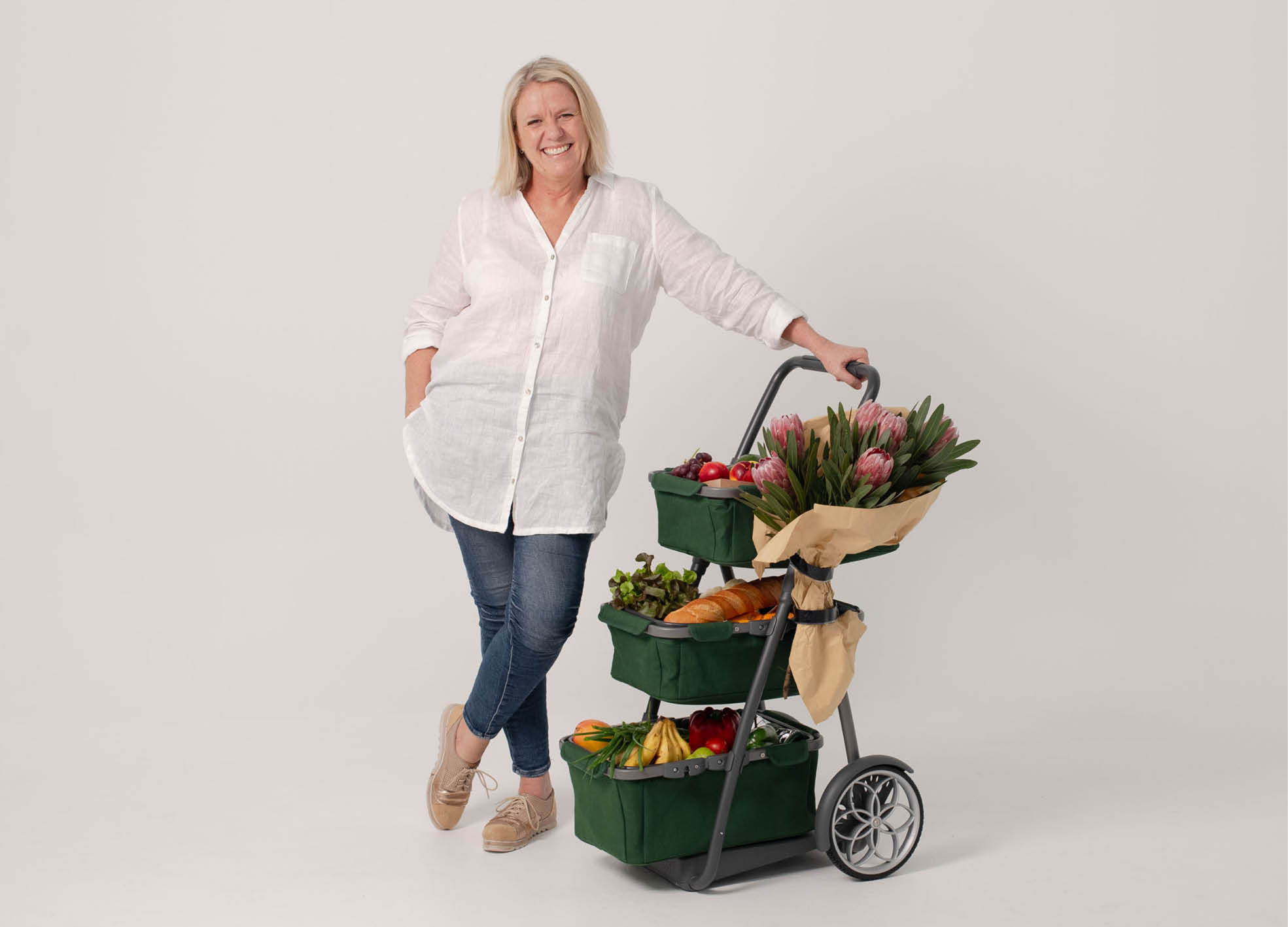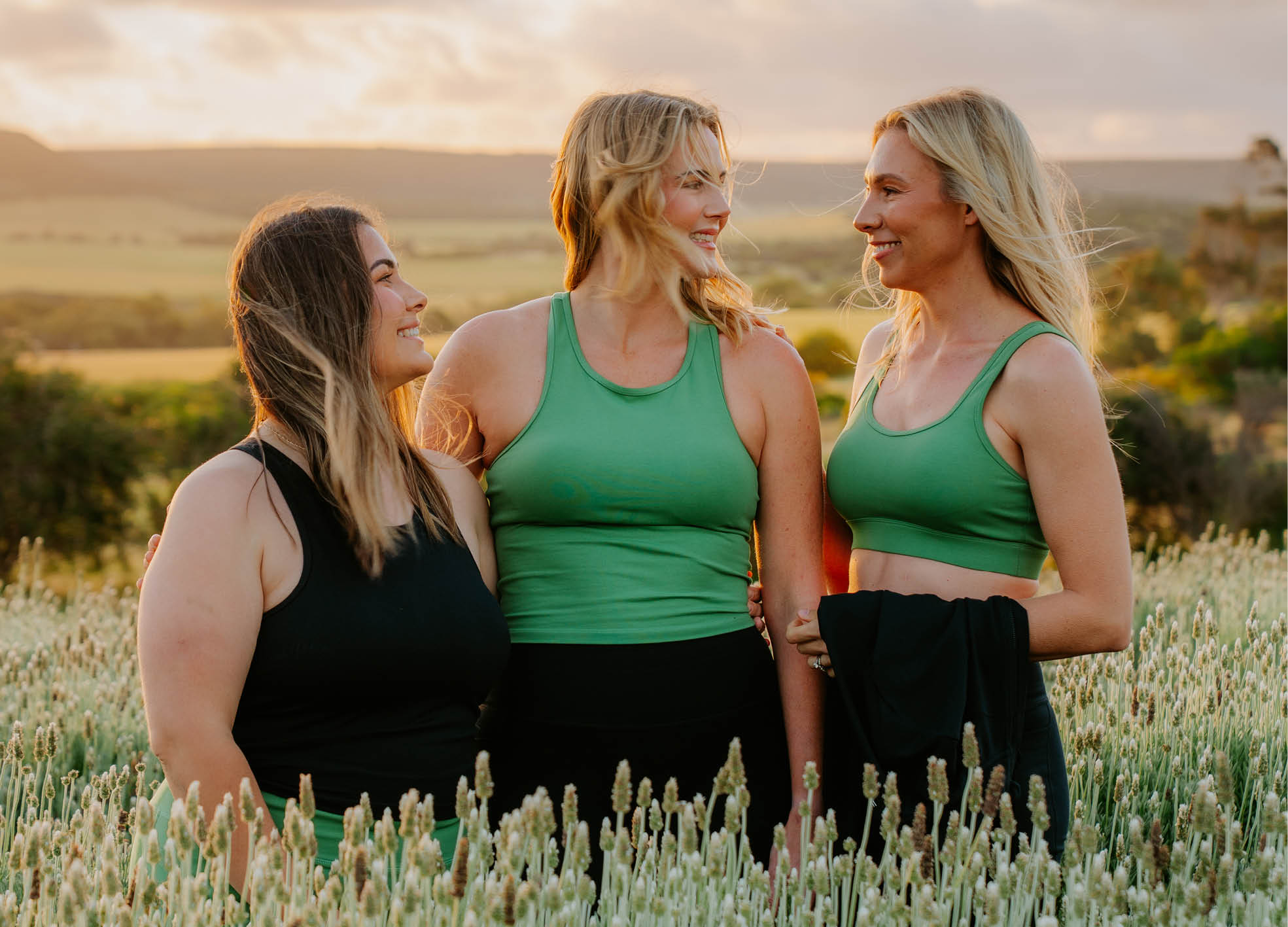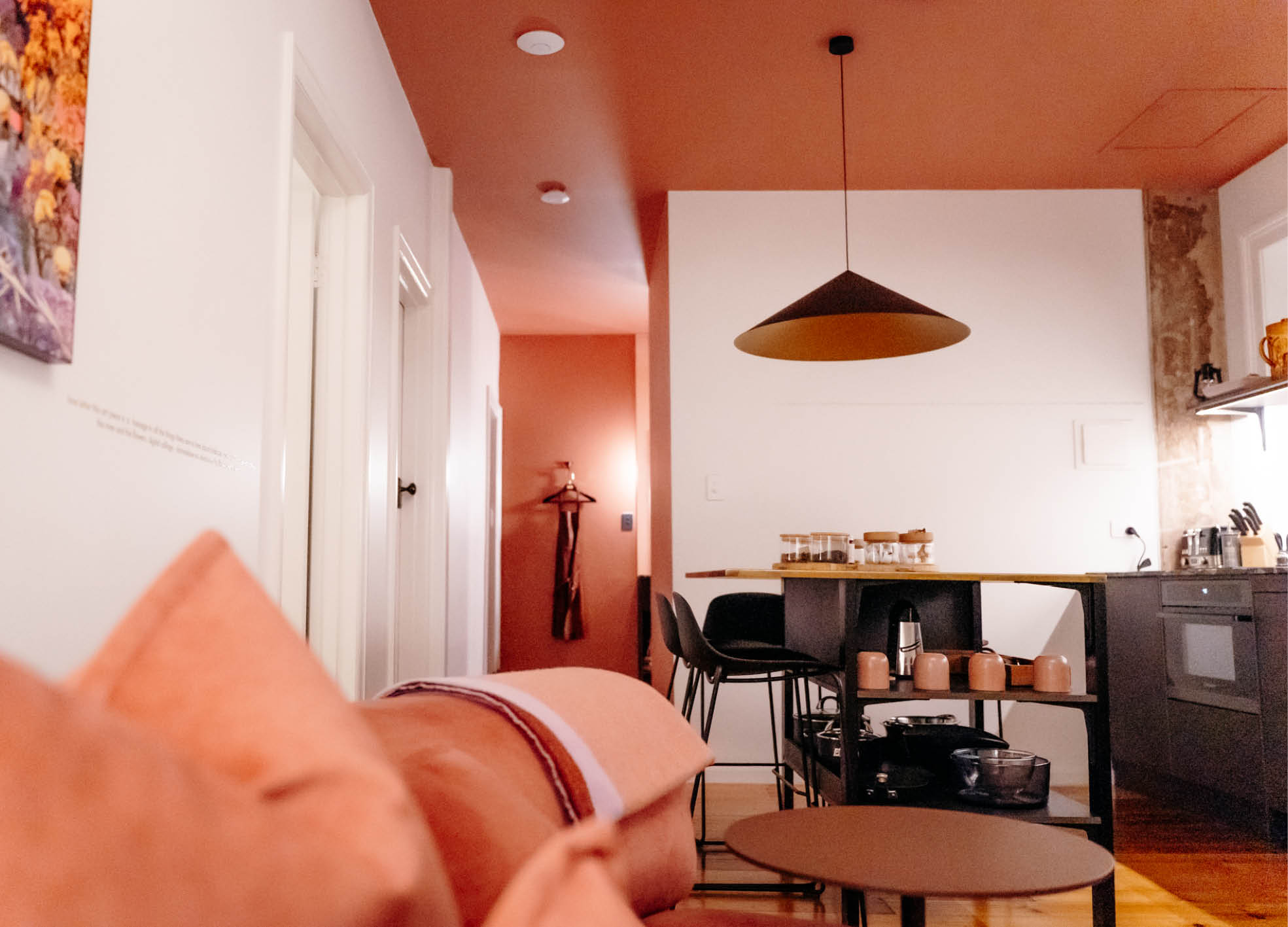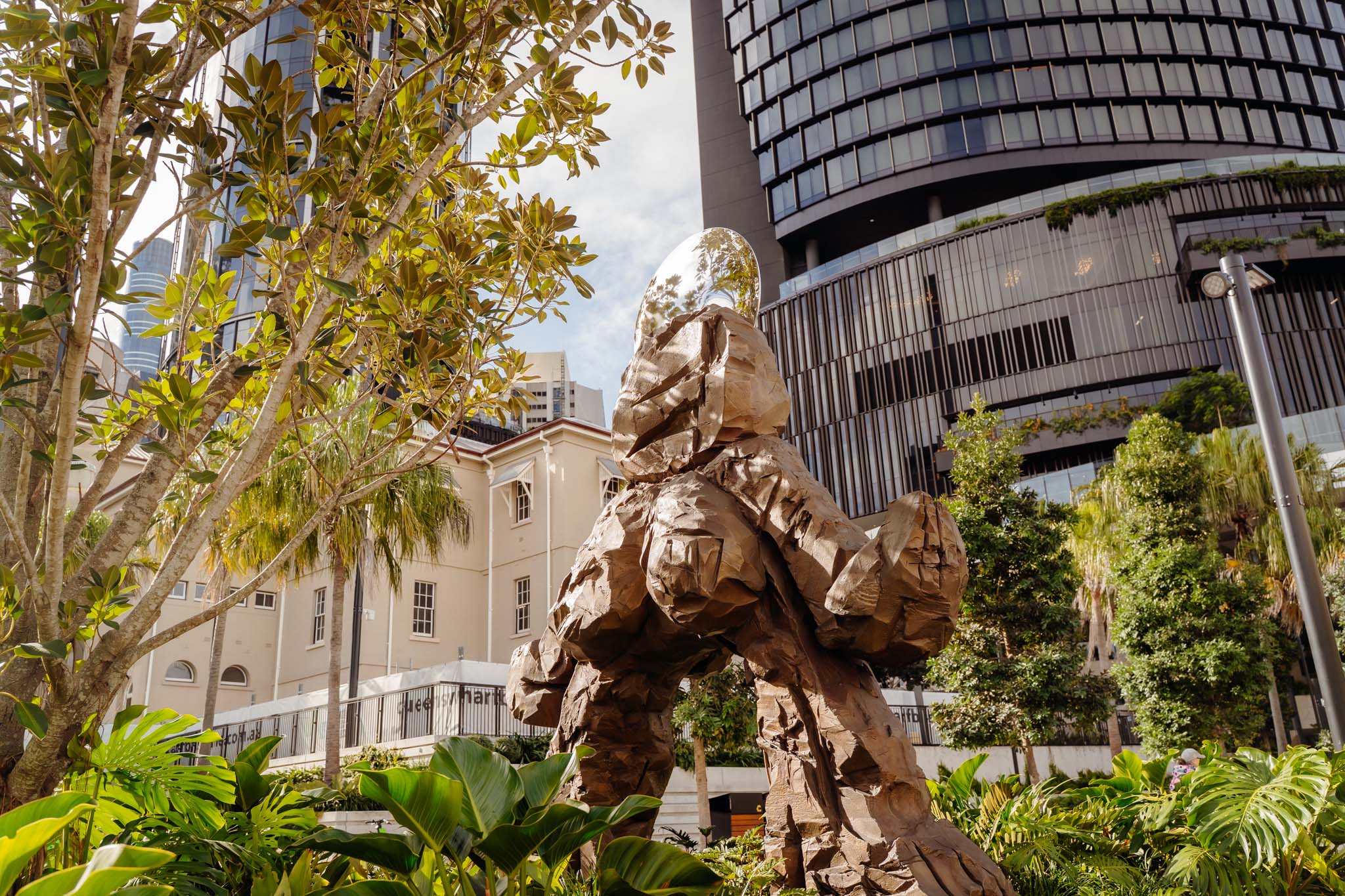Cut from the Same Cloth: A Love Story Beats at the Heart of This Fabric Store

- Words by Peppermint
photos MERRY AND THE MOON PHOTOGRAPHY
For Rebecca and Matthew Harper, Weft and Warp – an independent fabric store and sewing studio based in Canberra – is more than just bricks and mortar. It’s the realisation of a lifelong dream.


You’ve got a love story for the ages! Can you talk us through how you met your husband Matthew?
We met through our younger sisters who went to pre-school together in about 1980. This caused our mothers to meet, and they became friends. My mother-in-law owned a craft shop and Mum ended up working there one day a week. I don’t remember the exact point at which we met, but I would have been about seven years old and Matthew would have been 11. Our families spent lots of time together over the next few years and our younger sisters (two of mine and two of his) were quite good friends. You might say that Matthew and I tolerated each other as we grew up because of that inter-family relationship, but there was nothing more than that.
Fast-forward a few years. The craft shop closed and my mother-in-law went back to being a full-time teacher. My mum got a part-time job in a bank. Our family moved about half an hour away. We didn’t see Matthew’s family as much as we had.
One day when I was 19, Matthew called me out of the blue and invited me for lunch. I’d just broken up with my previous boyfriend and was looking forward to being single for a while. We went to the movies a couple of days later – to see Basic Instinct of all things! And at that point, something just clicked. Within two weeks we were talking about how the rest of our lives would be. We celebrated our thirtieth wedding anniversary this year.

above REBECCA AND MATTHEW ON THEIR WEDDING DAY
There’s something really beautiful about the matrilineal lore of sewing. Was it because of your mums that you fell in love with the magical world of textiles?
I have memories of Mum and Nanna sewing together to make items of school uniform for me when I was in kindergarten, so it wasn’t just one generation of example that I had. The whirr of the sewing machine was a constant throughout my childhood. Sewing clothes for us was just something that my mum did. I remember the excitement of Mum getting her first computerised machine in the early 80s and her learning to sew stretch fabrics by doing a Knitwit course. I still maintain that most of what I know about knit sewing was passively transmitted to me through the course as Mum worked through it.
I feel so incredibly lucky to have been raised in an environment where sewing was such a normal and natural thing. I never even thought twice about making clothes for myself.
One of the best parts about Mum getting her new machine was that I had almost unlimited access to her old one. By the time I started high school, I was so familiar with that machine I don’t actually remember doing very much sewing at school, despite studying Textiles until Year 10, because I was doing most of my sewing at home. I have such fond memories of that old Janome. It was used to sew important garments like my debutant ball dress, my Year 12 formal dress, and my wedding dress.
I feel so incredibly lucky to have been raised in an environment where sewing was such a normal and natural thing. I never even thought twice about making clothes for myself, even those “big event” ones that, with the benefit of hindsight now seem pretty ballsy to have attempted. Mum was always willing to answer questions and offer advice when needed. She never jumped in to rescue me from mistakes. It’s funny that since opening the shop, Mum now asks me for sewing advice!


When were those initial seeds of opening your own fabric store planted in your minds?
We first seriously considered the idea of opening a store about 10 years before we eventually acted upon it. Back then we were inspired by sewing cafes that were popping up around Europe – we loved the idea of having a space where people could come and sew, especially if they didn’t own their own machine or lived somewhere that didn’t have enough space for sewing. We had even identified a potential location, but it just didn’t make financial sense at the time.
I continued with my career as a high school science teacher, even going on to complete a Master of Education to improve my knowledge. But the idea of “Is there something else?” kept on niggling. Then the pandemic happened; nothing like a global pandemic to sharpen your focus on what you really want.
In January 2021, we were sitting at the top of Red Hill in Canberra looking out over the city below us. We were talking about life, the universe and everything. Matthew asked me what I would do if I could change course. I told him that he already knew the answer – that if I had the choice, I would open a fabric shop and teach people how to sew. And then he said to me, “Well, why don’t you?” That question really resonated with me and I could not shake it. Within three months we had signed a lease on a shop and were working towards opening.
Matthew asked me what I would do if I could change course. I told him that he already knew the answer.
Paint us a picture of your store…
We love watching the reaction of people as they walk up the ramp into the shop and catch sight of our beautifully colourful wall of fabric. It helps ignite the creative process for many. Before they get to the fabric, they will walk past our selection of independent pattern brands, chosen as much as possible for the quality of their instructions and their range of sizes. We also print lots of A0 patterns, purchased directly from designers, and can generally turn around printing orders within an hour during our opening hours.
Along the back wall of the shop, we have a large range of haberdashery and notions, including Australia’s most extensive collection of Prym products. We’re big fans of tools that make the home sewing process easier and more precise, so expect to find snap-fitting tools, ironing rulers, turning sets, rotary cutters and rulers. Of course, we also have dressmaking scissors, with five different left-handed options, and even more for those who are right-handed.
READ MORE – Add to Cart: The Indie Local Fabric Stores You Need to Know
As far as possible we try to stock things that help elevate your sewing beyond “home-made”. We have fold-over and picot-edge elastics for making your own undies. If you want to have a go at jeans, denim jackets or dungarees, we have Kylie and The Machine hardware and 35 different colours of Gutermann Denim Topstitching thread. A me-made hoodie can get a polished finish with metal eyelets and a metal-ended hoodie cord. We have a growing collection of spectacular Italian designer buttons that never fail to evoke strong emotional reactions, with some people choosing buttons and letting the buttons dictate pattern and fabric choices.
Beyond the retail section of the shop, we also have our sewing studio. Sharing our love and knowledge of sewing is an important part of what we do. In the studio, users have access to sewing machines, overlockers, a cover stitch machine, the most amazingly powerful ironing steam station and two large cutting tables, one of which is height adjustable. We offer open studio sessions for those who already know how to sew and just need some time or space or access to machines. Our sewing workshops are designed for every level of sewist, even those who have never sewed before.


You describe Weft and Warp as the product of a 30-year journey travelling the world, visiting sewing shops. What are a few of your favourites that you’ve found along your journey?
Wherever we go, I look for fabric stores, because no matter where you go, they’re all different. It’s sad that lots of the places I have visited no longer exist, so I’ll restrict my comments to what gems I have discovered on recent trips. Small, independent fabric shops are a bit of a rare species these days, so we tend to gravitate towards shops that are like ours because we can learn from them.
I really loved Raystitch in London. Despite their compactness, they managed to fit in a gorgeous range of fabrics and indie patterns, plus they have a classroom where they teach a range of really interesting workshops. Guthrie and Ghani in Birmingham is adorable, and again, it’s amazing what can be achieved in a space about half the size of what we have here in Canberra.
The thing that has really struck me on our travels is how in many places, a fabric shop is just a fabric shop. If you want anything other than fabric, apart from a limited range of thread, you generally have to go to another shop. We’re trying to be a bit different to this in what we are offering.
We just want people to know that whoever they are, wherever they are on their sewing journey, they are welcome in our shop.
What do you think independent retailers offer that distinguishes them from big box fabric stores? And why do you believe it’s so important for people to shop indie?
For us, it’s our experience as fellow home sewists that sets us apart from our larger competitors. We’re down in the trenches with our customers. We use our unpickers just as often as they do. Between our team members, we have experience with every independent pattern brand we sell. This means we can point out tips and tricks that may not be apparent until you have sewn one of these patterns. All of us also love nerding out about developments in the world of indie patterns, so if you don’t see something on the shelf that’s for you, we can often make suggestions of online brands worth looking at, because we have tried lots of them!
We play with the tools that come in and we happily recommend ones that have made our sewing easier. We can tell you what we’ve learned about using Maraflex for sewing knits. We can talk about the fabrics we’ve used. You will be encouraged to touch and unroll fabric, and to hold it up in front of a mirror to see whether the colours suit you, or how the fabric drapes.
Because we are all passionate about getting great results from our own sewing, we are equally passionate about trying to help our customers achieve the same thing.
READ MORE – Get Your Embroidery On Point with These Top Industry Tips
Fabrics you will find at independent retailers are different to what is offered at the larger stores. We try as much as possible to source fabrics with verifiable safety, labour and environmental standards. This generally means we are buying them out of Europe because these things are easier to trace than some other parts of the world. We have an educated customer base for whom such standards are important.
Shopping at an independent retailer, particularly at a physical shop such as ours, has impacts far beyond our little enterprise. We live in a world where so many shopping areas are just carbon copies of each other, with exactly the same chain stores, and almost no independent options. It’s pretty dull, to be honest. Independent retailers offer things that are different, quirky and unique. We have the flexibility and agility to curate what we offer to our customers, often in response to feedback and requests we get from them, and precisely because we are not tied into buying the sheer volumes of stock that larger retailers must.
Aside from the staff we directly employ, our very existence helps contribute to the viability of our local area. The coffee shop around the corner is just one example, as people drop in on their way to or from our shop. We are part of a larger ecosystem, and part of our community. When a local organisation put out a call for donations of machines and fabric for newly arrived migrant women, we were able to offer ourselves as a collection point for these items. Our ability to participate in this way helps build community.


Tell us about your community of customers…
Because of the online portion of our business, we have people from across Australia and even New Zealand who buy from us. It’s always amazing to see where parcels are being posted to, so that’s one part of our community.
As for the people who walk through our door, it’s such a spectrum of age, experience and gender. And they come to us for a variety of reasons. For many, it’s because sewing their own clothes is something they have always done, and they will continue to do so. For others, it’s because their needs aren’t being met by ready-to-wear clothing and they’re seeking something to fit the body they have. The motivations to sew are as varied as the people who visit us.
There’s the very fashion-forward woman in her sixties who refuses to be typecast by the “old lady clothes” she sees in the shops and makes the most amazing denim garments. We have a self-taught man in his twenties who loves 1950s-style clothing and drafts his own patterns to make the most amazing pants and waistcoats from our wool suiting. There are the people who have never sewn before and done our beginner classes who are now regulars and confidently attempting things like sleeve plackets and welt pockets.
Lots of people are returning to sewing after a break of many years and need some guidance and reassurance to navigate the brave new world of digital patterns, especially if they don’t consider themselves to be particularly tech-savvy. There have also been some changes in the types of fabrics available over the years, so some education on the new fabric types is often required.
It’s such a fantastic community, constantly growing. We just want people to know that whoever they are, wherever they are on their sewing journey, they are welcome in our shop.
The motivations to sew are as varied as the people who visit us.
What’s your favourite part about what you do?
That’s such a hard question to answer! Can I choose my two favourite things? I love getting to know our customers, learning about their needs, and then being able to greet them by name when they walk in the door. Maybe it was all those years as a high school teacher, but I am pretty good at remembering names. It’s by cultivating these relationships that we can be truly helpful to our customers.
As an example, I have a customer who lives about three hours away in regional New South Wales. She visits in person when she can, but we now know her preferred colour schemes so well that she can see a fabric on our website and phone to ask whether it is one that would work for her.
So the relationships are one thing I love, but I also adore teaching people to sew. Beginners are my favourite people to teach – I tend to hog these classes for myself and leave the more experienced learners to my other teachers! I draw heavily on my experience as a high school teacher in my approach and have a really clear focus on what I want them to know and achieve by the end of a workshop. Teaching adults is quite different to teaching teenagers. Learning a new set of skills always involves a level of discomfort and time to master them, and sometimes adults need additional reminders that it’s ok to be less than perfect when you start out. But from my perspective, it’s so gratifying seeing them develop into competent sewists.
THIS ARTICLE WAS ORIGINALLY PUBLISHED IN PEPPERMINT ISSUE 60 IN PARTNERSHIP WITH THE LOVELY FOLK AT WEFT AND WARP. FOR MORE FABRICS, INDIE PATTERNS, NOTIONS AND TOOLS, VISIT WEFTANDWARP.COM.AU.
JOIN OUR MAILING LIST
Brighten up your inbox with our not-too-frequent emails featuring Peppermint-related news, events, competitions and more!
explore
More articles
When you hang a painting on a wall, the story stays put. But when you wear a beautifully made garment that may as well be a piece of art? The story travels. It moves through the world with you –…
We all do it: fire up the car for a 5-minute drive to pick up groceries, drop off sewing supplies, or run a quick errand…
Here’s a question: who decided that natural fibres aren’t a great fit in activewear? For Geraldton mum-of-four Jade Payne, that question became paramount after a…
Fancy a getaway in a heritage building that was once a hospital, an orphanage AND a school in a previous life? Despite what your initial…
When the algorithm gods reward dance trends over hand-thrown ceramics, and building a website feels more stressful than a tax return, where’s a maker to…
Time-travelling lungfish floating in a mosaic of glass tiles, a four-breasted female empowerment goddess cast in bronze, and a striking botanical sculpture spanning 15 metres,…
Hang out with us on Instagram
“Crafting is something that has come naturally since I was small and I just haven’t stopped. When I was smaller, I was interested in the end result. As I’ve gotten older, I realise it’s the process that keeps me coming back to craft. It’s a meditative state for me and I find the repetitive action of the stitching and felting quite therapeutic.”
Craving a world filled with warmth and whimsy? It’s all in a day’s work for textile artist @Cat_Rabbit, whose latest book, ‘Trinkets’, is bursting with felty food friends to make and cherish. Cat invited us into her universe, filled with cheeky characters, layered storytelling and loads of humour.
Plus: try the super sweet pattern for Cat’s Lucky Pickle, perfect to make as a stocking stuffer, extracted from Trinkets.
Read more from our ‘Just felt right’ feature in Issue 64, at newsagents and stockists now!
Photos: Tatanja Ross @On_JacksonStreet and Cat Rabbit
#PeppermintMagazine #CatRabbit #LuckyPickle #Craft #Crafting #Felting #FeltCrafts #Trinkets #ChristmasDecorations

Our hearts go out to everyone impacted by the Bondi Beach violence, especially the Jewish community. Also to the beachgoers, those who bravely helped and the first responders.
While it`s easy – and understandable – to get caught up in the horror of it all and direct anger at certain groups, remember this quote from teacher and author Erin Gruwell: "Don`t let the actions of a few determine the way you feel about an entire group."
“You don`t fight racism with racism. You fight racism with solidarity," said Bobby Seale of the Black Panthers. And solidarity is exactly what we need right now.
If you are feeling overwhelmed, you are not alone. Remember there is much more kindness in the world than hate. ❤️🩹
@LifelineAustralia has created a Bondi Beach Incident: Wellbeing support guide, where you’ll find information about common reactions, reassurance that what you’re feeling is valid, and ideas for taking care of your wellbeing.
https://lifeline.org.au/bondi-incident
You can also call Lifeline on 13 11 14, text on 0477 13 11 14 or chat at lifeline.org.au/crisis-chat anytime, no matter how this has impacted you.
@BeyondBlueOfficial is also available with free 24/7 support by phone on 1300 22 4636 or webchat at https://www.beyondblue.org.au/
Register.Find.Reunite. has been activated by @RedCrossAu to help people reconnect with family and friends. Visit redcross.org.au to access the service.
@NSWPolice Public Information and Inquiry Centre (PIIC) is operating 24/7 on 1800 227 228 for information relating to people impacted.
@LifeBloodAu is supporting Sydney hospitals. O- and O+ blood are always in high demand in emergencies. To donate (from anywhere in Australia – all states are welcome and helpful!) call 13 14 95 or use the Lifeblood app.

Just a reminder… from @SugarHouseCeramicCo
This holiday season be kind, patient and shop local!
#ShopSmall #ShopLocal #SupportSmallBusiness

✨️ Our website is getting a glow-up! ✨️
Sorry for the inconvenience but it will be offline for a few days. You can still purchase subscriptions (perfect for chrissy presents!) via the links on the holding page.
Last year we were extremely excited to receive funding from the Meta Australian News Fund, in partnership with the Walkley Foundation. The result of this is a fabulous new website, with a sustainable fashion and sewing directory that will follow early next year. We`ve worked with the lovely Amy and Jenny at @CrumpetClubHouse who have been making the magic happen – we can`t wait to show you the outcome! ✨️
In the meantime, please get in touch if you need help with anything – hello@peppermintmag.com
We`ll see you on the other side! 🌈

🎀 12 DAYS OF XMAS GIVEAWAYS 🎀
🎄On the 12th day of Christmas, we’re giving away… a GREENPAN FROST ICE CREAM & FROZEN DRINK MAKER! 🎄
Ice, ice, baby! Calling all kitchen magicians and dessert devotees: it’s time to churn, blend and devour your way to frozen heaven. It’s our final giveaway – and hoo girl, it’s a goodie! Thanks to the clever folks at @TheOriginalGreenPan.Anz, one reader will cool their mitts on the Frost Ice Cream & Frozen Drink Maker – perfect for conjuring up home-made gelato, sorbet, smoothies, slushies and more!
Valued at $599, the Frost Ice Cream & Frozen Drink Maker is designed with GreenPan’s signature Thermolon™ ceramic non-stick coating, so you can whip up summer-ready sweet treats free of PFAS, PFOA, lead and cadmium.
To snag this frosty prize, follow @TheOriginalGreenPan.Anz and tag a friend in the comments below before midday AEST 15 December! (Australian and New Zealand addresses only, please.) Good luck!
Update: The lucky winner of our final giveaway is @just__for__van - congrats! We`ll dm to get your details. Well done! 🎉
#PeppermintMagazine #12DaysOfChristmas #12DaysOfGiveaways #GreenPan

Oh hey 👋🏼 Just a little reminder that our subscriptions are sent in paper envelopes, which is a bit of a rarity in our industry. 💅🏼
If you need more reasons to subscribe, how about these:
💌 Enjoy a new issue arriving in your letterbox every six months.
💌 Subscribers exclusively receive FOUR digital sewing patterns per year!
💌 You’ll be the first to get your hands (and needles) on our patterns with early access.
💌 Get a 20% discount code on back issues of Peppermint so you can start your collection today!
💌 Automatically go in the draw to win amazing prizes each issue.
💌 Feel good about your subscription arriving in plastic-free postage.
💌 Support a small, women-led Australian business.
💌 Help us make the world a better place!
And... it`s a perfect Christmas present! We have a downloadable card you can print to go with your gift.
💌 Link in bio!
#PeppermintMagazine #SupportSmallBusiness #ShopLocal #ShopSustainable #PlasticFree











